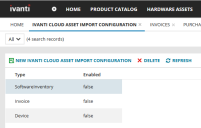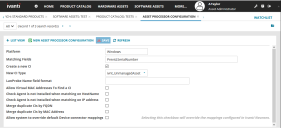Importing data from Ivanti Neurons
This topic is specific to Asset Manager Cloud.
You can import asset data from Ivanti Neurons using the connector (OData Connection) designed for your data source. You must be an Asset Administrator to do this and have accounts for both Ivanti Neurons and Asset Manager Cloud.
There are three types of records you can import into Asset Manager from Ivanti Neurons:
1.Software inventory – Licensable software records that will display in two places:
•The Hardware Assets workspace > Licensable Software tab for individual devices with that software installed.
•The Software Assets workspace > Installations tab for a manufacturer, listing all devices with that software installed.
2.Invoices – Records for vendor invoices that are associated with asset purchase orders. These will display in the Invoices workspace.
3.Devices – Hardware asset records that will display in the Hardware Assets workspace.
Before you begin
You must have all aspects of your Ivanti Neurons account set up and ready to use with Asset Manager Cloud. This includes:
•Reviewing the two emails from Ivanti regarding your account. The first contains the URL to the Ivanti Neurons website along with account details, and the second contains the encrypted password needed to access the account.
•Working with your Ivanti representative to ensure that the tenants for both Ivanti Neurons and Asset Manager are set up to communicate with each other during the data transfer.
•Configuring the Ivanti Neurons connector for your data source. For details, see the product help in Ivanti Neurons or under the Ivanti Neurons link at help.ivanti.com.
Ensure that you're current on all Asset Manager content package updates, which are available from the Ivanti Marketplace.
In Asset Manager, enable the types of records you want to import.
Note that this workspace includes a New Ivanti Neurons Asset Import Configuration option that is for future use only.
1.Open the Ivanti Neurons Asset Import Configuration workspace.
2.In the list view, double-click the record type you want to import. Note that by default, all record types are turned off (shown as false).
3.Click the Enabled check box.
4.Click Save, then click List View. Repeat for each record type you want to import.
Enabled record types should now display as true, which means that the Ivanti Neurons connector will actively import data for that type until you disable it again.
Next, ensure that the following CI (asset) type configurations are enabled in the Asset Processor Configuration workspace for Windows:
The New CI Type is set to unmanaged (ivnt_UnmanagedAsset) by default, though you can change the type as needed. It's recommended that you leave the Matching Fields as is.
Optional but recommended
In Asset Manager, you can create device parent type/subtype filters and field mappings that define how the Ivanti Neurons connector will import your source asset data. These customizations are useful when importing a large number of devices into Asset Manager at one time. For details, see Customizing asset data imports.
If you don't create field mappings for devices imported from Ivanti Neurons:
Device records will display in the Hardware Assets workspace as the CI (asset) type specified in the Asset Processor Configuration workspace (by default, unmanaged). Once the records are imported, you'll need to manually change their status to a managed asset type and subtype by following the procedure below.
The import process
You’ll need to be logged in to both Ivanti Neurons and Asset Manager Cloud to monitor the end-to-end process as it occurs.
The general steps for the import are:
•In Ivanti Neurons, run the data connector to start the process. The connector will begin pulling records into Ivanti Neurons from the data source, then over into Asset Manager. If needed, you can set a schedule in Ivanti Neurons for recurring imports. You can only run one connector at a time.
It should take no longer than several minutes for the import process to begin populating the Asset Manager database. If this doesn't occur, contact Ivanti customer support for assistance.
•In the Asset Manager > Integration Queue workspace, monitor the progress, which may take a while. Refresh the page as often as needed. You’ll see the status of the import job go from Queued to Running to Completed. The job will disappear from this workspace when completed.
•Review the Message Queue Journal workspace for incoming messages processed from Ivanti Neurons. Click Decompress Message (top right of page) to view the data details about specific discovered devices.
•Imported records will display in the correct workspace for the record type, as mentioned above. You may need to refresh those workspaces (Hardware Assets, Software Assets, and Invoices) before the data displays.
If you didn't customize how the Ivanti Neurons connector imports source asset data, device records will display in the Hardware Assets workspace as unmanaged by default. You'll need to manually change the status of these records to a managed asset type and subtype.
1.Open the Hardware Assets workspace.
2.In the list view, expand Asset Type: ivnt_UnmanagedAsset.
3.Manually select the records in the list.
4.In the upper-right area of the page, click the More drop-down menu and select Administration Actions > Change Asset Type.
5.In the Enter dialog, select the correct type and subtype from the drop-downs.
6.Click OK. The workspace list view will update accordingly.
